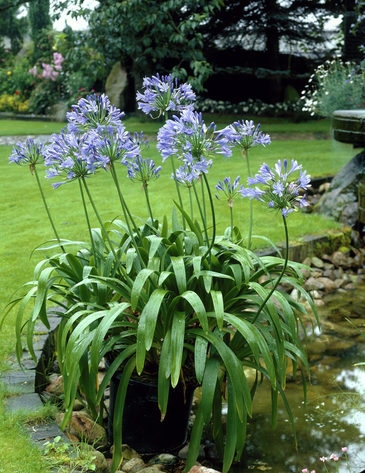Agapanthus Propagation: Tips for Expanding Your Plant Collection
Agapanthus Propagation: Tips for Expanding Your Plant Collection
Blog Article
Letting Loose the Secret to Successful Agapanthus Growing: Advice for a Flourishing Yard
In the realm of horticulture, growing agapanthus efficiently requires a tactical strategy that incorporates different elements of plant care. By comprehending the subtleties of agapanthus farming, one can produce an atmosphere where these plants grow and bloom abundantly.
Planting Agapanthus: Finest Practices
When growing Agapanthus, appropriate soil prep work is essential for ensuring effective development and advancement of these gorgeous blossoms. Agapanthus, commonly referred to as Lily of the Nile or African lily, grows in well-draining dirt with a somewhat acidic to neutral pH level - Agapanthus. Before growing, it is vital to change hefty clay soils with raw material such as garden compost or peat moss to enhance drain and supply crucial nutrients for the plants
To plant Agapanthus, pick an area that receives full sunshine to partial color, as this will advertise healthy and balanced growth and abundant flowering. Dig a hole twice the diameter of the plant's origin round and place the Agapanthus at the same depth it was formerly growing. Carefully backfill the hole with soil, weighing down securely to eliminate any type of air pockets around the origins.
Water the recently grown Agapanthus extensively and remain to keep the soil uniformly moist, particularly throughout the plant's active expanding season. Agapanthus. Applying a balanced plant food once a month can additionally support the plant's growth and flowering. By adhering to these best practices for growing Agapanthus, you can produce a spectacular display of these captivating flowers in your garden
Ideal Soil Conditions for Agapanthus
For optimal growth and blooming success of Agapanthus plants, making sure the soil problems are excellent is important. Agapanthus favors soil that is rich in nutrients, so incorporating a balanced fertilizer during the expanding period can advertise healthy development and lively flowers.

Watering and Fertilizing Tips
To ensure healthy growth and lively flowers, correct watering and feeding strategies are necessary for successful Agapanthus farming. Agapanthus plants profit from normal watering, specifically throughout the expanding period.
When it involves feeding Agapanthus, a balanced plant food with equal components nitrogen, phosphorus, and potassium can be applied in the spring to advertise healthy growth and flowering. Slow-release plant foods are suitable for providing nutrients progressively over an extended period. Stay clear of over-fertilizing, as this can cause excessive foliage development at the expenditure of blossoms.
Furthermore, incorporating organic matter like garden compost right into the soil can improve nutrient degrees and improve soil framework, helping in the total wellness of the Agapanthus plants. By adhering to these watering and fertilizing suggestions, gardeners check my source can ensure their Agapanthus plants thrive and produce spectacular displays of flowers.
Trimming and Deadheading Techniques
Appropriate trimming and deadheading techniques play an essential duty in maintaining the health and wellness and aesthetics of Agapanthus plants, complementing the essential methods of watering and feeding for successful farming. Pruning Agapanthus entails eliminating spent blossom heads, yellowing or dead leaves, and general shaping of the plant to advertise better growth. Deadheading, the process of getting rid of discolored flowers, not just boosts the plant's appearance but likewise urges more blooming.
When deadheading Agapanthus, it is suggested to clip off the blossom stem at the base using sharp, clean shears. This procedure redirects the plant's energy from seed production back right into root and foliage growth, promoting a healthier and more robust plant. Routine deadheading can prolong the blooming duration of Agapanthus and stop self-seeding, which can lead to overcrowding.
In terms of trimming, Agapanthus usually gain from a light trim after blossoming to clean the plant and urge fresh growth. Cutting down the invested flower stems and eliminating any dead or broken foliage assists maintain the plant's vigor and general look. However, it is important to stay clear of cutting into the crown of the plant, as this can damage its health.

Protecting Agapanthus From Vermins and Diseases
Carrying out effective bug and condition management techniques is critical to guarding the health and vitality of Agapanthus plants in farming. One typical insect that influences Agapanthus is the Agapanthus borer, a caterpillar that passages right into the plant, creating damages to the flowers and fallen leaves.
In enhancement to insects, Agapanthus are at risk to conditions such as root rot and fungal leaf places. These problems can frequently be stopped by making sure appropriate drain and staying clear of overwatering. Influenced parts of the plant need to be promptly removed to stop further spread if indications of disease show up. Fungicides may additionally be made use of as a therapy measure, following the supplier's instructions very carefully. By staying cautious and addressing insect and illness problems without delay, gardeners can assist their Agapanthus prosper and thrive.

Verdict
Finally, effective farming of agapanthus website here calls for appropriate useful reference growing methods, optimal dirt problems, sufficient watering and fertilizing, routine pruning and deadheading, and protection from insects and illness. By adhering to these pointers and techniques, garden enthusiasts can guarantee a flourishing yard full of stunning agapanthus flowers. Agapanthus. Remember to maintain constant care and focus to information to advertise the health and long life of these magnificent plants
When planting Agapanthus, appropriate dirt preparation is necessary for ensuring successful development and development of these lovely flowers.Water the recently planted Agapanthus completely and continue to keep the soil evenly damp, especially throughout the plant's active expanding season.For ideal development and growing success of Agapanthus plants, guaranteeing the soil problems are excellent is crucial. When planting or transplanting Agapanthus, ensure the dirt is well-prepared to offer the required structure for the plants to develop themselves effectively. One usual pest that impacts Agapanthus is the Agapanthus borer, a caterpillar that tunnels into the plant, creating damages to the fallen leaves and flowers.
Report this page